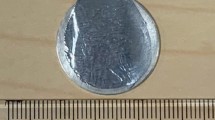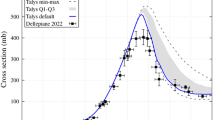Abstract
Utilization of (p, 4n) reaction channel for the production of medical radionuclides became very attractive with commercial availability of medium energy cyclotrons. Significantly higher yields and radionuclidic purity may open new perspectives for several novel and some of the radionuclides previously have not been considered due to production difficulties. In present work, we show the proof-of-principle study on the production of 86Y for Positron Emission Tomography imaging via radionuclide generator 86Zr → 86Y. Production suitability of 86Zr from natural yttrium target and radiochemical separation strategies were tested. In addition, two generator systems were proposed and evaluated.






Similar content being viewed by others
References
Rosch F, Baum RP (2011) Generator-based PET radiopharmaceuticals for molecular imaging of tumors: on the way to THERANOSTICS. Dalt Trans 40:6104–6111. https://doi.org/10.1039/c0dt01398f
Penet MF, Chen Z, Kakkad S et al (2012) Theranostic imaging of cancer. Eur J Radiol 81:S124–S126. https://doi.org/10.1016/S0720-048X(12)70051-7
Herrmann K, Larson SM, Weber WA (2017) Theranostic concepts: more than just a fashion trend—introduction and overview. J Nucl Med 58:1S–2S. https://doi.org/10.2967/jnumed.117.199570
Nagarajah J, Janssen M, Hetkamp P, Jentzen W (2017) Iodine symporter targeting with 124I/131I theranostics. J Nucl Med 58:34S–38S. https://doi.org/10.2967/jnumed.116.186866
Ahn BC (2012) Sodium iodide symporter for nuclear molecular imaging and gene therapy: from bedside to bench and back. Theranostics 2:392–402. https://doi.org/10.7150/thno.3722
Muller C, Bunka M, Haller S et al (2014) Promising prospects for 44Sc-/47Sc-based theragnostics: application of 47Sc for radionuclide tumor therapy in mice. J Nucl Med 55:1658–1664. https://doi.org/10.2967/jnumed.114.141614
Herzog H, Rösch F, Stocklin G et al (1993) Measurement of pharmacokinetics of yttrium-86 radiopharmaceuticals with PET and radiation dose calculation of analogous yttrium-90 radiotherapeutics. J Nucl Med 34:2222–2226
Nayak TK, Brechbiel MW (2011) 86Y based PET radiopharmaceuticals: radiochemistry and biological applications. Med Chem (Los Angeles) 7:380–388. https://doi.org/10.2174/157340611796799249
Müller C, Reber J, Haller S et al (2014) Folate receptor targeted alpha-therapy using terbium-149. Pharmaceuticals 7:353–365. https://doi.org/10.3390/ph7030353
Müller C, Vermeulen C, Köster U et al (2017) Alpha-PET with terbium-149: evidence and perspectives for radiotheragnostics. EJNMMI Radiopharm Chem 1:5. https://doi.org/10.1186/s41181-016-0008-2
International Atomic Energy Agency (2009) Therapeutic radionuclide generators: 90Sr/90Y and 188W/188Re generators. International Atomic Energy Agency, Vienna Technical report series No. 470, 233 pp
Kettern K, Linse KH, Spellerberg S et al (2002) Radiochemical studies relevant to the production of 86Y and 88Y at a small-sized cyclotron. Radiochim Acta 90:845–849. https://doi.org/10.1524/ract.2002.90.12_2002.845
Kandil SA, Scholten B, Hassan KF et al (2009) A comparative study on the separation of radioyttrium from Sr- and Rb-targets via ion-exchange and solvent extraction techniques, with special reference to the production of no-carrier-added 86Y, 87Y and 88Y using a cyclot. J Radioanal Nucl Chem 279:823–832. https://doi.org/10.1007/s10967-008-7407-0
Reischl G, Rösch F, Machulla HJ (2002) Electrochemical separation and purification of yttrium-86. Radiochim Acta 90:225–228. https://doi.org/10.1524/ract.2002.90.4_2002.225
Yoo J, Tang L, Perkins TA et al (2005) Preparation of high specific activity 86Y using a small biomedical cyclotron. Nucl Med Biol 32:891–897. https://doi.org/10.1016/j.nucmedbio.2005.06.007
Lukić D, Tamburella C, Buchegger F et al (2009) High efficiency production and purification of 86Y based on electrochemical separation. Appl Radiat Isot 67:523–529. https://doi.org/10.1016/j.apradiso.2008.12.008
Rösch F, Qaim SM, Stöcklin G (1993) Production of the positron emitting radioisotope 86Y for nuclear medical application. Appl Radiat Isot 44:677–681. https://doi.org/10.1016/0969-8043(93)90131-S
Sadeghi M, Aboudzadeh M, Zali A, Zeinali B (2009) 86Y production via 86Sr(p, n) for PET imaging at a cyclotron. Appl Radiat Isot 67:1392–1396. https://doi.org/10.1016/j.apradiso.2009.02.038
Rösch F, Herzog H, Qaim SM (2017) The beginning and development of the theranostic approach in nuclear medicine, as exemplified by the radionuclide pair 86Y and 90Y. Pharmaceuticals 10:1–28. https://doi.org/10.3390/ph10020056
International Atomic Energy Agency (2009) Cyclotron produced radionuclides: physical characteristics and production methods. International Atomic Energy Agency, Vienna Technical report series No. 468, 266 pp
Filosofov DV, Loktionova NS, Rösch F (2010) A 44Ti/44Sc radionuclide generator for potential application of 44Sc-based PET-radiopharmaceuticals. Radiochim Acta 98:149–156. https://doi.org/10.1524/ract.2010.1701
Dirks C, Happel S, Bombard A, Maudoux N (2015) On the characterisation of an hydroxamate based extraction chromatographic resin. In: 61st RRMC, Iowa
Uddin MS, Hagiwara M, Baba M et al (2005) Experimental studies on excitation functions of the proton-induced activation reactions on yttrium. Appl Radiat Isot 63:367–374. https://doi.org/10.1016/j.apradiso.2005.04.006
Yang S-C, Song T-Y, Lee Y-O, Kim G (2017) Production cross sections of proton-induced reactions on yttrium. Nucl Instrum Methods Phys Res Sect B 398:1–8. https://doi.org/10.1016/j.nimb.2017.03.021
Firestone RB, Shirley VS (1998) Table of isotopes. Wiley, New York
Marhol M (1982) Ion exchangers in analytical chemistry. Academia, Prague
Horwitz EP, Chiarizia R, Dietz L (1992) A novel strontium-selective extraction chromatographic resin. Solvent Extr Ion Exch 10:212–336. https://doi.org/10.1080/07366299208918107
Marinov GM, Marinova AP, Medvedev DV et al (2016) Determination of distribution coefficients (Kd) of various radionuclides on UTEVA resin. Radiochim Acta 104:735–742. https://doi.org/10.1515/ract-2016-2582
Acknowledgements
We thank the Phasotron team for performing the yttrium targets irradiations. We also thank to Dr. Steffen Happel from Triskem International for providing samples of ZR-resin.
Funding
Financial support of this project was provided by the Russian Foundation for Fundamental Research Grants (RFBR 15-53-12372), by the Program for graduate and postgraduate students in the framework of collaboration between JINR laboratories, JINR Member States and the Czech scientific institutions, by the joint Czech Republic—JINR representatives committee Grant No.: 03-2-1100-2010/2018 and Health Research Agency of the Czech Republic and the Ministry of Education Youth and Sports of the Czech Republic and the EU, grant No’s.: NV16-30544A and CAP-CZ.02.1.01/0.0/0.0/15_003/0000464. TRIUMF receives funding via a contribution agreement with the National Research Council of Canada.
Author information
Authors and Affiliations
Corresponding author
Rights and permissions
About this article
Cite this article
Baimukhanova, A., Radchenko, V., Kozempel, J. et al. Utilization of (p, 4n) reaction for 86Zr production with medium energy protons and development of a 86Zr → 86Y radionuclide generator. J Radioanal Nucl Chem 316, 191–199 (2018). https://doi.org/10.1007/s10967-018-5730-7
Received:
Published:
Issue Date:
DOI: https://doi.org/10.1007/s10967-018-5730-7




